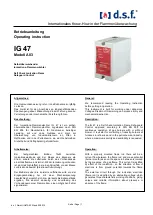
G08 Vector Monitor Guide
Page 37 of 41
Appendix B: Testing Transistors
Most of the failures in the Electrohome G08 monitor (as is the case with most electronic devices)
are semiconductor failures, specifically, the transistors. All transistors discussed in this document
can be tested in the same way; it does not matter if they are the large chassis-mounted transistors or
the tiny PCB-mounted transistors. With the transistors out of circuit, set your multi-meter on Rx1K
scale and use the following procedures.
NOTE: ANALOG AND DIGITAL MULTI-METERS REQUIRE DIFFERENT TESTING
PROCEDURES FOR TRANSISTORS!
Digital meters always show infinite resistance for all 6
combinations (if you accidentally get your skin involved it will show something around 2M Ohms).
The best way to test transistors with a DMM is to make use of the "diode test" function, which will
be described after the analog test. For both methods, if you read a short circuit (0 Ohms or voltage
drop of 0) or the transistor fails any of the readings, it is bad and must be replaced.
Why do Digital Voltmeters read open circuits on diodes and transistors?
Because of the ability to use amplifiers, DVM can use much smaller voltages to check resistance.
For the most part this is a good thing. It allows you to check resistors in circuit, without turning on
things, like transistors.
Diode junctions (which there are two of in a transistor) do not “turn on” until they reach
somewhere around 0.4 ~ 0.7 volts, depending upon what they are made of, and a lot of other stuff.
In a way, diode junctions are similar to neon light bulbs, they act like open circuits until the right
voltage is reached, and then they act like shorts, until the voltage drops below the critical threshold.
Without proper current limiting, the diode junctions explode. The thing about diodes is that they
only do this in one direction, if you switch the test leads, they do not conduct at all. (Well, until the
voltage gets
much
higher, and then it is a bad thing. ;^)
Sometimes you want to be able to “turn on” the diode junctions (to test them), so DVMs have a
“Diode” test mode. This places enough voltage on the test leads to turn on the diode junction. The
number you read on most meters is the actual turn on voltage threshold across the diode.
TESTING TRANSISTORS WITH AN ANALOG OHMMETER
For type NPN transistors, lead "A" is black and lead "B" is red; for type PNP transistors, lead "A"
is red and lead "B" is black (
NOTE
: this is the standard polarity for resistance but many multi-
meters have the colors reversed; if the readings do not jive this way, switch the leads and try it
again). Start with lead "A" of your multi-meter on the base and lead "B" on the emitter. You should
get a reading of 2.5K Ohms. Now move lead "B" to the collector. You should get the same reading.
Now try the other 4 combinations and you should get a reading of infinite Ohms (open circuit). If
any of these resistances is wrong, replace the transistor. Only 2 of the 6 possible combinations
should show a resistance and that value should be 2.5K Ohms; none of the resistances should be 0
Ohms (shorted).
Содержание G08 Series
Страница 42: ......






































